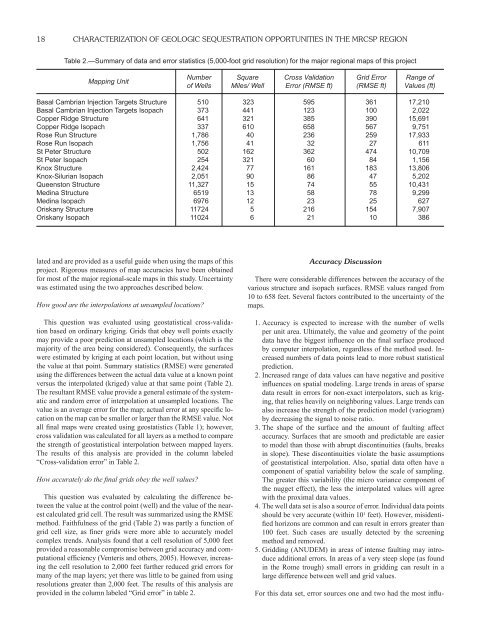MRCSP Phase I Geologic Characterization Report - Midwest ...
MRCSP Phase I Geologic Characterization Report - Midwest ...
MRCSP Phase I Geologic Characterization Report - Midwest ...
Create successful ePaper yourself
Turn your PDF publications into a flip-book with our unique Google optimized e-Paper software.
18 CHARACTERIZATION OF GEOLOGIC SEQUESTRATION OPPORTUNITIES IN THE <strong>MRCSP</strong> REGION<br />
Table 2.—Summary of data and error statistics (5,000-foot grid resolution) for the major regional maps of this project<br />
Mapping Unit<br />
Number Square Cross Validation Grid Error Range of<br />
of Wells Miles/ Well Error (RMSE ft) (RMSE ft) Values (ft)<br />
Basal Cambrian Injection Targets Structure 510 323 595 361 17,210<br />
Basal Cambrian Injection Targets Isopach 373 441 123 100 2,022<br />
Copper Ridge Structure 641 321 385 390 15,691<br />
Copper Ridge Isopach 337 610 658 567 9,751<br />
Rose Run Structure 1,786 40 236 259 17,933<br />
Rose Run Isopach 1,756 41 32 27 611<br />
St Peter Structure 502 162 362 474 10,709<br />
St Peter Isopach 254 321 60 84 1,156<br />
Knox Structure 2,424 77 161 183 13,806<br />
Knox-Silurian Isopach 2,051 90 86 47 5,202<br />
Queenston Structure 11,327 15 74 55 10,431<br />
Medina Structure 6519 13 58 78 9,299<br />
Medina Isopach 6976 12 23 25 627<br />
Oriskany Structure 11724 5 216 154 7,907<br />
Oriskany Isopach 11024 6 21 10 386<br />
lated and are provided as a useful guide when using the maps of this<br />
project. Rigorous measures of map accuracies have been obtained<br />
for most of the major regional-scale maps in this study. Uncertainty<br />
was estimated using the two approaches described below.<br />
How good are the interpolations at unsampled locations<br />
This question was evaluated using geostatistical cross-validation<br />
based on ordinary kriging. Grids that obey well points exactly<br />
may provide a poor prediction at unsampled locations (which is the<br />
majority of the area being considered). Consequently, the surfaces<br />
were estimated by kriging at each point location, but without using<br />
the value at that point. Summary statistics (RMSE) were generated<br />
using the differences between the actual data value at a known point<br />
versus the interpolated (kriged) value at that same point (Table 2).<br />
The resultant RMSE value provide a general estimate of the systematic<br />
and random error of interpolation at unsampled locations. The<br />
value is an average error for the map; actual error at any specific location<br />
on the map can be smaller or larger than the RMSE value. Not<br />
all final maps were created using geostatistics (Table 1); however,<br />
cross validation was calculated for all layers as a method to compare<br />
the strength of geostatistical interpolation between mapped layers.<br />
The results of this analysis are provided in the column labeled<br />
“Cross-validation error” in Table 2.<br />
How accurately do the fi nal grids obey the well values<br />
This question was evaluated by calculating the difference between<br />
the value at the control point (well) and the value of the nearest<br />
calculated grid cell. The result was summarized using the RMSE<br />
method. Faithfulness of the grid (Table 2) was partly a function of<br />
grid cell size, as finer grids were more able to accurately model<br />
complex trends. Analysis found that a cell resolution of 5,000 feet<br />
provided a reasonable compromise between grid accuracy and computational<br />
efficiency (Venteris and others, 2005). However, increasing<br />
the cell resolution to 2,000 feet further reduced grid errors for<br />
many of the map layers; yet there was little to be gained from using<br />
resolutions greater than 2,000 feet. The results of this analysis are<br />
provided in the column labeled “Grid error” in table 2.<br />
Accuracy Discussion<br />
There were considerable differences between the accuracy of the<br />
various structure and isopach surfaces. RMSE values ranged from<br />
10 to 658 feet. Several factors contributed to the uncertainty of the<br />
maps.<br />
1. Accuracy is expected to increase with the number of wells<br />
per unit area. Ultimately, the value and geometry of the point<br />
data have the biggest influence on the final surface produced<br />
by computer interpolation, regardless of the method used. Increased<br />
numbers of data points lead to more robust statistical<br />
prediction.<br />
2. Increased range of data values can have negative and positive<br />
influences on spatial modeling. Large trends in areas of sparse<br />
data result in errors for non-exact interpolators, such as kriging,<br />
that relies heavily on neighboring values. Large trends can<br />
also increase the strength of the prediction model (variogram)<br />
by decreasing the signal to noise ratio.<br />
3. The shape of the surface and the amount of faulting affect<br />
accuracy. Surfaces that are smooth and predictable are easier<br />
to model than those with abrupt discontinuities (faults, breaks<br />
in slope). These discontinuities violate the basic assumptions<br />
of geostatistical interpolation. Also, spatial data often have a<br />
component of spatial variability below the scale of sampling.<br />
The greater this variability (the micro variance component of<br />
the nugget effect), the less the interpolated values will agree<br />
with the proximal data values.<br />
4. The well data set is also a source of error. Individual data points<br />
should be very accurate (within 10 1 feet). However, misidentified<br />
horizons are common and can result in errors greater than<br />
100 feet. Such cases are usually detected by the screening<br />
method and removed.<br />
5. Gridding (ANUDEM) in areas of intense faulting may introduce<br />
additional errors. In areas of a very steep slope (as found<br />
in the Rome trough) small errors in gridding can result in a<br />
large difference between well and grid values.<br />
For this data set, error sources one and two had the most influ-





